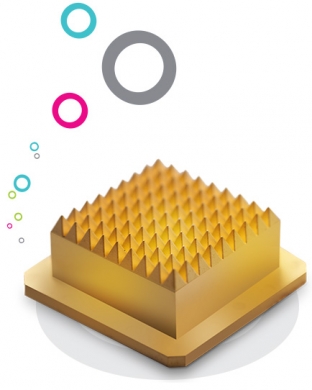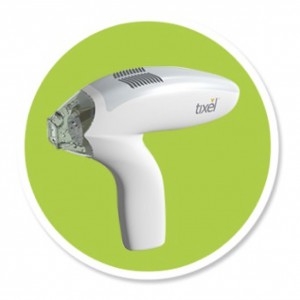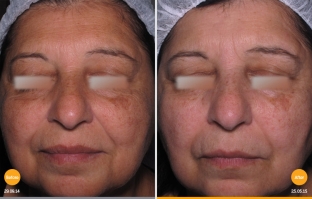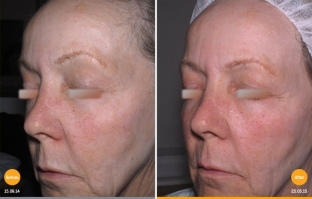Fractional skin rejuvenation technologies are widely used in dermatology. Short-pulse CO2 lasers are considered the best for high-precision ablation of thin skin layers without bleeding and with minimal side effects. These lasers are often used for fractional skin rejuvenation to improve skin texture and smooth fine lines. To hold a pretty painful procedures you must first apply anesthetic creams and wear goggles. The recovery period is approximately 5 days. This article evaluates the use of innovative thermomechanical ablation (TMA) technology with the Tixel device.
What is the Tixel Fractional Skin Rejuvenation System
The Tixel Fractional Skin Rejuvenation System (Novoxel, Germany) is a thermomechanical system for fractional ablation. The system uses a tip made of gold-plated metal biocompatible materials (Fig. 1A). The tip is fixed on the remote section of the Tixel handle equipped with a linear motor (Fig. 1B). The active surface of the tip consists of a group of 81 (9x9) pyramids evenly distributed over an area of 1x1 cm. The height of the pyramids is 1.25 mm, and the radius – 100 microns at the highest point of the pyramid. The back of the handpiece is flat and connects to a coin-sized heater that is kept at a constant temperature of 400oC during operation. When the device is not in use, the tip is set at a distance of 20 mm from the skin surface. The tip weighs 7g and is reusable.


Fig. 1 (A) Fig. 1 (C)
The system detects, checks, sterilizes and replaces handpieces automatically. Cleaning the handpiece after the procedure for 5 minutes at a temperature of 540 oC using an additional heater. Self-sterilization is carried out for three minutes at a temperature of 350 oC.
Handle Weight – 270 g. Two types of tips are used:
- D-tip with high thermal conductivity; and
- S-tip with low thermal conductivity.
When the user activates the handpiece, the linear motor quickly brings the handpiece into tissue contact. Thermal energy is transferred to the skin, creating micro-cavities in it through evaporation. The tip at the exact time departs to a controlled distance – to the initial position (Fig. 2).

Fig. 2
Pulse duration, i.e. the contact time of the tip with the skin varies from 6 ms to 18 ms. The two-pulse mode is activated. When using Tixel Fractional Skin Rejuvenation System does not require goggles or smoke extraction.
Tixel clinical results for fractional skin rejuvenation
| Number of patients | 26 |
| Level of pain during the procedureа,b | 3.1 |
| Recovery periodb | 0.16 days |
| Disappearance of rednessb | 3.5 days |
| Patient Satisfaction | 75% |
| Smoothing wrinkless | 75% |
aOn a scale of 1 (minimum) to 10 (maximum) without analgesia or pain relief
bAverage
cPercentage of patients who experienced wrinkle smoothing.

Summary on the Benefits of the Tixel System for Fractional Skin Rejuvenation
Fractional skin rejuvenation with Tixel – an innovative technology of thermal skin rejuvenation, during which ablative and non-ablative indentations are created in the skin. The superheating of water molecules in skin tissues by means of a high conductivity metal tip makes it possible to achieve efficient evaporation of skin cells with high precision, safety and predictable results.

D-tip creates ablative pits that are identical to those produced by fractional CO2 lasers. The settings allow using the S-tip to create non-ablative depressions in the skin, while thermal damage penetrates to the papillary dermis. Impact on the epidermal layer of depressions improves the healing process and provides rapid re-epithelialization and epidermal regeneration of the damaged area of the skin. Moreover, the cavity coating can act as a natural physiological protective layer that protects against post-procedure infections throughout the healing process.
This technology is safe and provides a good rejuvenating effect with virtually no recovery period. Smaller indentations than traditional lasers promote faster healing. Due to the short recovery period, additional treatments can be performed for optimal results.

The procedure itself is characterized by a low level of discomfort for the patient. The system is easy to use, and due to the absence of smoke, it does not require wearing goggles – there is no risk of negative effects of invisible laser radiation on the patient, the doctor or the staff of the institution. The morbidity of the procedure is very low, the application of anesthetic creams is not required. Unlike lasers, which require patient anesthesia and cooling to reduce pain, when using the Tixel system, patients do not ask to numb the treated skin areas either before or after the procedure. The low level of pain is due to several factors:
- smaller dimple diameter compared to lasers;
- Even though the energy delivered to the recess is the same as when using a laser, Tixel uses a fraction of the energy density;
- The entire array of 81 Tixel pits is created in one step of 15ms duration, while a higher energy density laser beam is directed about 100 times of 0.5ms duration to create a 1-cm2 treatment area.
Further studies are needed to better evaluate this technology, and this clinical evaluation has been helpful in quantitatively and qualitatively understanding the capabilities of the Tixel system. Based on the data obtained, it can be concluded that Tixel is a universal fractional system for ablative and non-ablative skin rejuvenation.







Add a comment